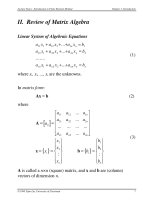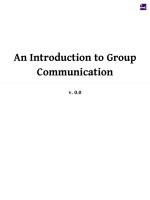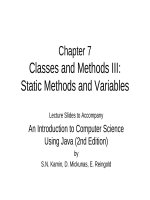Wireless networks - Lecture 2: Introduction to Wireless communication
Bạn đang xem bản rút gọn của tài liệu. Xem và tải ngay bản đầy đủ của tài liệu tại đây (501.29 KB, 38 trang )
Wireless Networks
Lecture 2
Introduction to Wireless Communication
Dr. Ghalib A. Shah
1
Outlines
Review of previous lecture #1
Wireless Transmission
Encoding/Modulation
Noises
Losses/Gain
Summary of today’s lecture
2
Last Lecture Review
Objectives of course
Course syllabus
Wireless vision
► Driving factors
•
•
•
Tetherless connectivity
VLSI technology
Success of 2G systems
► Wireless Prons/Cons
► EM Signal
•
•
•
Time domain concept: analog, digital, periodic, aperiodic,
Amplitude, frequency, period, wavelength
Frequency domain concept: fundamental frequency, spectrum,
absolute bandwidth, effective bandwidth
Channel capacity: Nyquist formulation, SNR, Shannon formula
► EM Spectrum
3
Trans mis s io n in Wire le s s Do main
Bas e band S ig nal
► o btaine d by c o nve rting analo g o r dig ital data
into analo g o r dig ital s ig nal, bandwidth = [0,
fmax)
Bandpas s S ig nal
► bandlimite d s ig nal who s e minimum fre que nc y is
diffe re nt fro m ze ro , bandwidth = [f1, f2)
4
Wireless Transmission
virtually impossible to transmit baseband signals in
wireless domain.
single transmission medium (air) for all users and
applications.
in wired networks, new wiring can be added to
accommodate new applications/users – one wire for
telephone, one for cable, one for LAN, etc.
antenna size must correspond to signal’s wavelength
► 1 MHz signal few 100 m-s high antenna;
► 1 GHz signal few cm-s high antenna
characteristics of wireless-signal propagation heavily
depend on signal’s frequency
low-frequency signals ‘tilt downwards’ and follow the
Earth’s surface
► do not propagate very far
5
Signal Encoding/Modulation
We are concerned with transmitting digital data.
Some transmission media will only propagate
analog signals e.g., optical fiber and unguided
media
Therefore, we will discuss transmitting digital
data using analog signals.
The most familiar use of this transformation is
transmitting digital data through the public
telephone network.
6
Encoding
Each pulse in digital signal is a signal element.
Binary data are transmitted by encoding each data bit into signal
elements.
1
0
1
0
1
0
There can be one-to-one correspondence between data elements
and signal elements or one-to-multiple/multiple-to-one
Data rate: the rate in bits/sec that data are transmitted
Modulation rate: the rate at which signal element is changed and
is expressed in baud i.e. signal elements/second.
7
Encoding
The duration or length of bit is the amount of
time it takes for the transmitter to emit the bit.
For data rate R, bit time is 1/R.
At receiver
► the bit time must be known i.e. start and end time of
bit.
► The encoding must be known i.e. high (1) and low
(0)
► These tasks are performed by sampling each bit
position at middle of interval and comparing the
value to threshold.
8
Carrier and Information Signals
carrier signal: In radio frequency systems an
analog signal is always used as the main
airborne signal
Information Signal: On top of this signal
another signal, analog or digital, is added that
carries the information
Modulation: This combination of signals is
called the modulation
9
9
Modulation
Modulation is how an information signal is
added to a carrier signal
This is the superimposing of the information
onto the carrier
In an RF system a modulator generates this
information signal
Then it is passed to the transmitter and out the
antenna
10
10
Modulation
Then at the other end the signal is
demodulated
The way to think of this is like a letter
► The envelope is the carrier and the letter is the
information
► The envelope is only needed during transmission
Three types
► AM
► FM
► PM
11
11
Modulation
AM
FM
PM
12
Types of Encoding
There are three forms of Encoding
► ASK – Amplitude-Shift Keying
► FSK – Frequency-Shift Keying
► PSK – Phase-Shift Keying
13
13
Amplitude Shift-Keying (ASK)
ASK changes the height of the sine wave as
time goes by
The two binary values are represented by two
different amplitudes of the carrier frequency.
One binary digit represented by presence of carrier, at
constant amplitude
Other binary digit represented by absence of carrier
14
14
ASK
Susceptible to sudden gain changes
Inefficient modulation technique
On voice-grade lines, used up to 1200 bps
Used to transmit digital data over optical fiber
15
Binary Frequency Shift-Keying (BFSK)
FSK changes the frequency of the sine wave as
time goes by, without changing the height
Two binary digits represented by two different
frequencies near the carrier frequency
16
16
Binary Frequency-Shift Keying (BFSK)
Less susceptible to error than ASK
On voice-grade lines, used up to 1200bps
Used for high-frequency (3 to 30 MHz) radio
transmission
Can be used at higher frequencies on LANs
that use coaxial cable
17
Multiple Frequency-Shift Keying (MFSK)
More than two frequencies are used
More bandwidth efficient and less susceptible to error
To match data rate of input bit stream, each output
signal element is held for:
T s=LT seconds
•
where T is the bit period (data rate =1/T)
f i = f c + (2i – 1 – M)f d
•
•
•
•
f c =the carrier frequency
f d =the difference frequency
M =number of different signal elements = 2 L
L =number of bits per signal element
18
Multiple Frequency-Shift Keying (MFSK)
19
Phase-Shift Keying (PSK)
PSK changes the phase of successive sine
waves
Two-level PSK (BPSK)
► Usess two
binary 1binary digits
A cos 2 to
f t represent
phases
t
c
A cos 2 f c t
binary 0
A cos 2 f c t
A cos 2 f c t
binary 1
binary 0
20
20
PSK
In general when you see phase modulation
schemes explained B stands for binary, which
is only 2 points. Q stands for quadrature,
which is 4 points and 16 and 64 represent the
higher number of points in the modulation
schemes
21
21
PSK
Every time the number of points is increased
the speed is increased, but interference
tolerance is reduced
This is one of the reasons for automatic speed
reduction in the face of interference
Going from binary - 2 to 64 requires a really
clean signal
22
22
Noise
Noise consists of all undesired radio signals,
whether manmade or natural
Noise makes the reception of useful
information difficult
The radio signal’s strength is of little use, if the
noise power is greater than the received signal
power
This is why the signal to noise ratio is important
23
23
Categories of Noise
Thermal Noise
Intermodulation noise
Crosstalk
Impulse Noise
24
Thermal Noise
Thermal noise due to agitation of electrons
Present in all electronic devices and transmission
media
Cannot be eliminated
Function of temperature
Particularly significant for satellite communication
25









